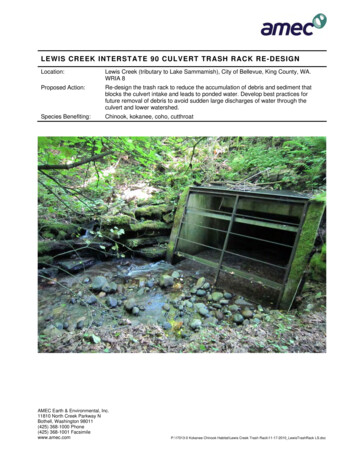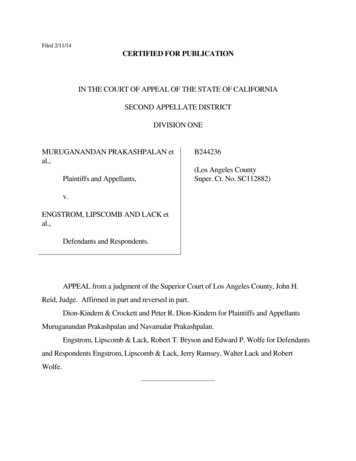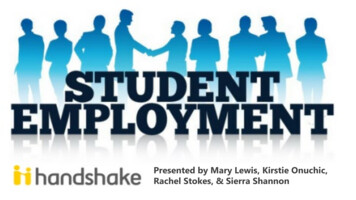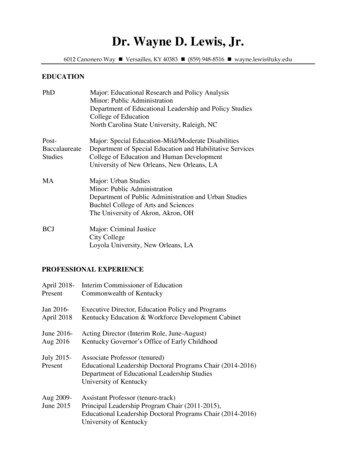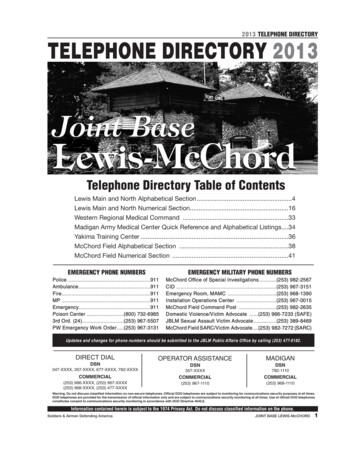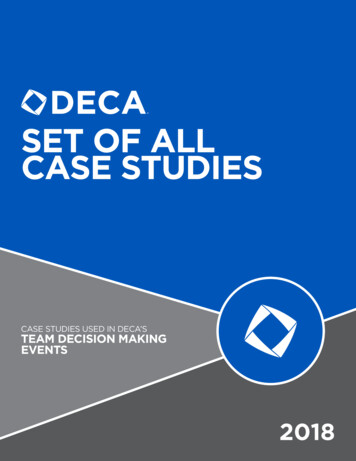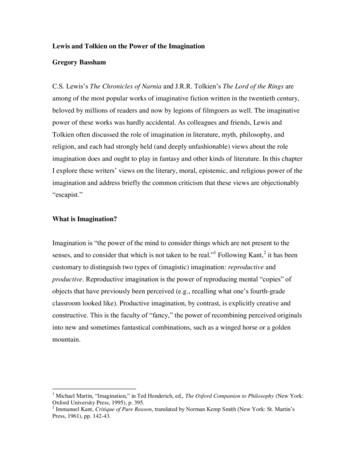
Transcription
Lewis and Tolkien on the Power of the ImaginationGregory BasshamC.S. Lewis’s The Chronicles of Narnia and J.R.R. Tolkien’s The Lord of the Rings areamong of the most popular works of imaginative fiction written in the twentieth century,beloved by millions of readers and now by legions of filmgoers as well. The imaginativepower of these works was hardly accidental. As colleagues and friends, Lewis andTolkien often discussed the role of imagination in literature, myth, philosophy, andreligion, and each had strongly held (and deeply unfashionable) views about the roleimagination does and ought to play in fantasy and other kinds of literature. In this chapterI explore these writers’ views on the literary, moral, epistemic, and religious power of theimagination and address briefly the common criticism that these views are objectionably“escapist.”What is Imagination?Imagination is “the power of the mind to consider things which are not present to thesenses, and to consider that which is not taken to be real.”1 Following Kant,2 it has beencustomary to distinguish two types of (imagistic) imagination: reproductive andproductive. Reproductive imagination is the power of reproducing mental “copies” ofobjects that have previously been perceived (e.g., recalling what one’s fourth-gradeclassroom looked like). Productive imagination, by contrast, is explicitly creative andconstructive. This is the faculty of “fancy,” the power of recombining perceived originalsinto new and sometimes fantastical combinations, such as a winged horse or a goldenmountain.1Michael Martin, “Imagination,” in Ted Honderich, ed., The Oxford Companion to Philosophy (New York:Oxford University Press, 1995), p. 395.2Immanuel Kant, Critique of Pure Reason, translated by Norman Kemp Smith (New York: St. Martin’sPress, 1961), pp. 142-43.
2Lewis distinguishes three kinds of productive imagination.3 Reverie involves brief,episodic daydreaming or castle-building, usually featuring oneself in some pleasing orwish-fulfilling scenario (like imagining oneself hitting a home run in Yankee Stadium orgoing on a Caribbean cruise). Invention involves creating an imagined world or narrativethat is more detailed than is typically the case with mere reverie, which may or may notbe pleasing, and which generally does not include oneself as a protagonist. Trollope’sBarsetshire, Stevenson’s Treasure Island, and Plato’s ideal republic are examples ofinvention. Finally, fantasy (in the literary sense) is a form of imaginative invention thatinvolves “impossibles and preternaturals,”4 such as elves, trolls, wizards, unicorns,dragons, or time travel. Swift’s Gulliver’s Travels, Tolkien’s The Lord of the Rings, andLewis’s Narnia books and Space Trilogy are works of fantasy in this sense. In thischapter, I will focus primarily on Lewis’s and Tolkien’s views on the power ofimagination in literary fantasy. As I read them, Lewis and Tolkien suggest six ways inwhich fantasy can excite and expand the imagination.Fantasy Broadens Our Perspective and Enlarges Our Sense of What Is PossibleAs Lewis notes, one of the special attractions of works of science fiction and fantasy istheir power to give us “sensations we never had before, and [to] enlarge our conceptionof the range of possible experience.”5 Such works can help us see through other eyes,reveal possibilities outside the range of our limited, workaday lives, and satisfy deepseated human desires to “hold communion with other living things” 6 and to encountertrue “otherness.”Both realist literature and works of fantasy are able to excite our imaginations. But ingiving us “sensations we never had before” and enlarging “our range of possibleexperience,” fantasy is indisputably superior to realist literature. What would it be like to3C.S. Lewis, Surprised By Joy: The Shape of My Early Life (New York: Harcourt Brace, 1955), p. 15.C.S. Lewis, An Experiment in Criticism (Cambridge: Cambridge University Press, 1961), p. 50.5C.S. Lewis, “On Science Fiction,” in Of Other Worlds: Essays and Stories, edited by Walter Hooper(New York: Harcourt Brace Jovanovich, 1966), p. 70.6J.R.R. Tolkien, “On Fairy-stories,” reprinted in The Tolkien Reader (New York:: Ballantine Books, 1966),p. 15.4
3be an ordinary bear like Lewis’s Mr. Bultitude, or a fifteen-inch-high creature likeReepicheep? How would a naturally immortal or long-lived being such as Legolas orTreebeard look on the passing flow of time? What kind of flora and fauna might exist onanother planet? What would it be like to be an “unfallen” creature, such as Lewis’shrossa, or a being, such as Tom Bombadil, who lacks all possessiveness and all desire todominate other wills? All of these imagination-expanding questions are posed in Lewis’sand Tolkien’s fiction.Fantasy Can Re-enchant the Ordinary WorldIn his dense, diffuse, but brilliantly suggestive essay “On Fairy-stories,” Tolkien suggeststhat fantasy can bring “recovery,” a restoration of our Wordsworthian ability to seeordinary things (“stone, and wood, and iron; tree and grass; house and fire; bread andwine”7) with fresh, childlike wonder.8In Tolkien’s Lord of the Rings, it is primarily the elves who symbolize the sanative powerof recovery. Like the mysterious nature-divinity, Tom Bombadil, Tolkien’s elves possessa remarkable ability to take delight in things simply because they are “other.” As virtualimmortals, the elves dwelling in Middle-earth are grieved by the flow of time, but do noteasily succumb to ennui, or boredom. Unlike humans, who have, as Tolkien says, a“quick satiety with good,” 9 the elves have an almost endless appetite for poetry, songs,gazing at the stars, and walking in sunlit forests. Whereas humans see a beautiful sunsetand say “ho-hum,” the elves see it with ever-fresh wonder and delight.How does fantasy help us rediscover wonder and delight in “the other”? It does so byhelping us pierce what Tolkien calls the “drab blur of triteness and familiarity.” 10 By7Ibid., p. 59.The following three paragraphs are adapted from my essay, “Tolkien’s Six Keys to Happiness,” inGregory Bronson and Eric Bronson, The Lord of the Rings and Philosophy: One Book to Rule Them All(Chicago: Open Court, 2003), pp. 58-59.9The Letters of J.R.R. Tolkien, edited by Humphrey Carpenter (Boston: Houghton Mifflin, 1981), p. 344.10Tolkien, “On Fairy-stories,” p. 57.8
4juxtaposing the enchanted with the familiar, the magical with the mundane, fantasyprovides vivid contrasts that help us see the world with fresh eyes. Having encounteredents and towering mallorns, we forever see ordinary elms and beeches differently. Rockand tree, leaf and branch, shadow and sunlight become again, as they were in childhood,wondrous and strange. The blue ocean and green earth once again become “mightymatter[s] for legend” (LOTR 2: 29). We pierce what Lewis calls the “veil offamiliarity” 11 and begin to see the world as elves see it: as miraculous and charged withthe grandeur of Ilúvatar the Creator.Fantasy Can Activate Our Moral ImaginationsTolkien once remarked that one of his objects in writing The Lord of the Rings was “theelucidation of truth, and the encouragement of good morals in this real world, by theancient device of exemplifying them in unfamiliar embodiments, that may tend to ‘bringthem home.’”12 As a work of moral fiction, The Lord of the Rings belongs with Bunyan’sPilgrim’s Progress and Dickens’s David Copperfield in the front rank of Englishliterature. Baylor professor Ralph Wood, who regularly teaches courses on Tolkien,reports that many of his students “have confessed that they feel ‘clean’ after reading TheLord of the Rings.” By this, says Wood, they refer “not chiefly to the book’s avoidance ofdecadent sex but . . . to its bracing moral power: its power to lift them out of the smallminded obsessions of the moment and into the perennial concerns of ethical and spirituallife.”13The “bracing moral power” of The Lord of the Rings works chiefly on two levels. First,Tolkien’s heroes inspire us as moral exemplars. When we read of the selfless, doggedpersistence of Frodo, the indomitable courage of Sam, the loyalty of Merry and Pippin,the nobility of Aragorn, the repentance of Boromir, or the humility of Galadriel, we feel11C.S. Lewis, “The Dethronement of Power,” reprinted in Neil D. Isaacs and Rose A. Lombardo, eds.,Tolkien and the Critics: Essays on J.R.R. Tolkien’s The Lord of the Rings (Notre Dame: University ofNotre Dame Press, 1968), p. 15.12Tolkien, Letters, p. 194.13Ralph C. Wood, The Gospel According to Tolkien: Visions of the Kingdom in Middle-earth (Louisville:Westminster John Knox Press, 2003), pp. 75-76.
5the allurement of goodness that Plato classically describes in the Symposium. We aremoved, energized, and uplifted. We dream of better things, and desire to grow.A second way in which The Lord of the Rings fires our moral imaginations is by showingus visions of utopian and dystopian realities. In Hobbiton we feel the charm of a closeknit, rustic community in a bygone age when there was “less noise and more green.” 14 Inthe Hobbits’ love of simple things—well-ordered and well-farmed countryside, goodfriends, good food, good pipe-weed, and good beer—we are ruefully reminded of ourown frazzled, macadamized, gadget-filled lives. By contrast, in Mordor’s hellishmoonscape and Isengard’s smoking pits we see terrifying visions of a future that could beours should humanity’s courage or wisdom fail. By means of such starkly contrastingvisions, Tolkien activates our imaginations as no reasoned argument could.If one of Tolkien’s aims in writing The Lord of the Rings was “the encouragement ofgood morals,” this motive is even more apparent in Lewis’ Chronicles of Narnia. AsGilbert Meilaender remarks, the Narnia tales “are not just good stories. Neither are theyprimarily Christian allegories . . . . Rather, they serve to enhance moral education, tobuild character. They teach, albeit indirectly, and provide us with exemplars from whomwe learn proper emotional responses.”15As Meilaender points out, the Narnia stories are the direct embodiment, in fiction, ofviews on moral education that Lewis defends in The Abolition of Man (1944). In thatwork, Lewis critiques moral subjectivism and argues for a classical view of ethics asgrounded in self-evident moral axioms. He also defends a classical view of how moralcharacter is best developed. According to this classical model, moral growth requiresthree things: instruction in basic moral principles; role models to provide support,inspiration, and concrete guidance; and the development of good moral habits, or virtues,14J.R.R. Tolkien, The Hobbit (New York: Ballantine/Del Rey, 2001), p. 3.Gilbert Meilaender, The Taste for the Other: The Social and Ethical Thought of C.S. Lewis (GrandRapids, MI: Eerdmans, 1978), p. 213.15
6through repeated performance of morally correct actions.16 Each of these requirements ofmoral growth is featured prominently in the Chronicles. The children are frequentlyinstructed on ethical fundamentals by wise preceptors, such as Aslan, Puddleglum, Dr.Cornelius, the Professor, Coriakan, and the Hermit of the Southern March. They learnfrom a variety of role models: Reepicheep, Mr. and Mrs. Beaver, Prince Rilian, KingTirian, among others. And the children grow morally—become braver, kinder, wiser, andmore confident—by passing successfully through a variety of trials and adventures thattest their moral mettle and enable them to form habits of virtuous response.According to Plato and other defenders of the classical model of moral education, storiesplay a crucial role in moral development. Stories engage our moral imagination, providevivid moral exemplars, and activate our affections in ways that instruction or reasoneddiscourse (especially when directed at children) often does not. Stories are a primarymeans of teaching children the “right responses” to morally charged situations beforethey have reached the age of “reflective thought.” Beyond the rollicking adventures,beyond the religious symbolism, The Chronicles of Narnia is a “book of virtues” thatseeks to fulfill this classic educational function in a world that, Lewis believed, wasincreasingly morally and imaginatively impoverished.In the Narnia tales, this ethical and imaginative impoverishment is symbolized chiefly byExperiment House, the modern, “up-to-date” school that Eustace Scrubb and Jill Poleattend. At Experiment House children are allowed to do what they like, bullies areregarded as interesting psychological cases, and fuzzy, “non-factual” subjects like myth,poetry, fiction, ethics, and religion are largely excluded (SC, 549-551). As a result,students at Experiment House tend to be, like Uncle Andrew and the Witch Jadis,“dreadfully practical” (MN, 75). (Eustace, we are told, “liked animals, especially beetles,if they were dead and pinned to a card. He liked books if they were books of informationand had pictures of grain elevators and of fat foreign children doing exercises in modelschools” (VDT, 425).) The moral effects of such schools, Lewis believed, are disastrous.16Bill Davis, “Extreme Makeover: Moral Education and the Encounter with Aslan,” in Gregory Basshamand Jerry L. Walls, eds., The Chronicles of Narnia and Philosophy (Chicago: Open Court, 2005), pp. 109110.
7Having “read none of the right books” (VDT, 463) and totally lacking the “emotionsorganized by trained habit into stable sentiments”17 that are essential to good moralcharacter, Eustace becomes a “record stinker” (VDT, 426): stuck-up, lazy, insensitive,resentful, and totally self-absorbed. It is only when he enters the morally rich atmosphereof Narnia, suffers the isolating and dehumanizing effects of being turned into a dragon,and is subsequently cured through the painful “baptism” of Aslan (VDT, 465-76), that heis set on the right moral path.As we have seen, Lewis believed that the classical model of moral education—stressingthe threefold process of instruction, role
Imagination is “the power of the mind to consider things which are not present to the . 2 Immanuel Kant, Critique of Pure Reason, translated by Norman Kemp Smith (New York: St. Martin’s Press, 1961), pp. 142-43. 2 Lewis distinguishes three kinds of productive imagination.3 Reverie involves brief, episodic daydreaming or castle-building, usually featuring oneself in some pleasing or wish .
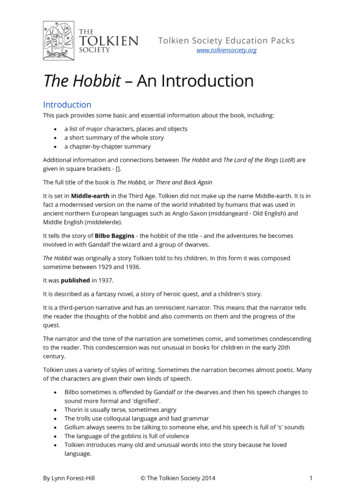
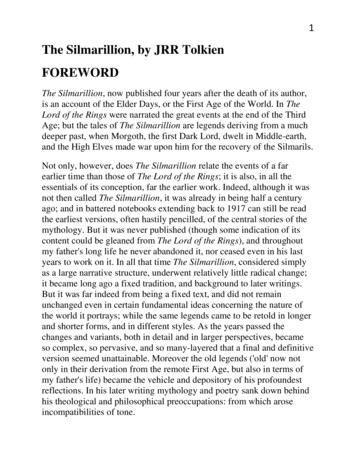

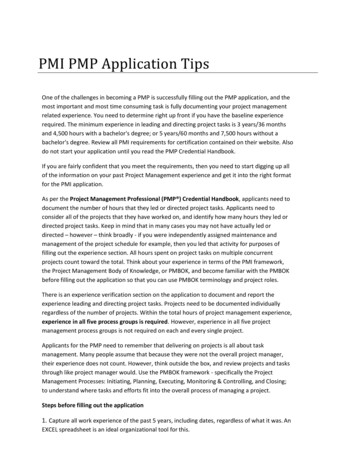
![Drawings of Leonardo da Vinci [by Charles Lewis Hind]](/img/6/cnm45b2242355.jpg)
